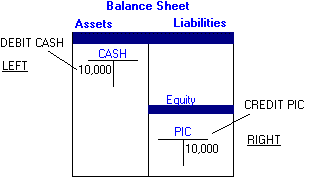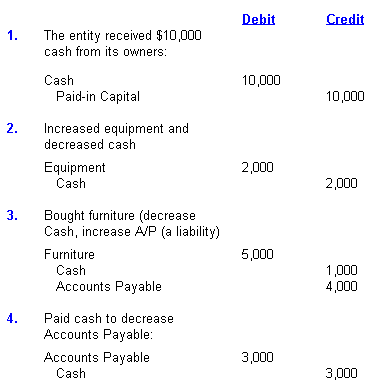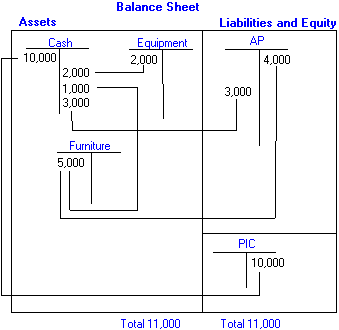Rules for Debit and Credit
We have stated the basic accounting equation:
Assets = Liabilities + Equity
There is also another accounting equation:
Debits = Credits
This equation applies to every transaction. It is a useful error-checking device because if you try to record a transaction in such a way that the debits do not equal the credits, you know that something is wrong.
For this equation to work, the rules for liabilities and equity must be the opposite of the rules for assets. The reason for this can be illustrated by the first transaction given earlier. In that transaction, Cash was increased $10,000, and Paid-in Capital, an equity account, was also increased by $10,000. The instruction for the increase in Cash is Debit Cash, $10,000. The instruction for the increase in Paid-in Capital cannot be Debit Paid-in Capital, $10,000.
If this were done, there would be debits totaling $20,000 and no credits; therefore, the rule for Paid-in Capital has to be, record increases as credits. If you follow this rule, the debit of $10,000 to Cash equals the credit of $10,000 to Paid-in Capital; that is, debits = credits. If increases in Paid-in Capital are credits, then decreases must be debits.

These rules apply to all liability and equity accounts. To increase a liability or equity account, you credit it; to decrease a liability or equity account, you debit it.
To remember these rules, think of the accounts in relation to the balance sheet. You always enter debits on the left-hand side of the account. Assets are on the left-hand side of the balance sheet. As a result, increases in assets are debits. Credits are always entered on the right-hand side of the account. Liabilities and equity items are on the right-hand side of the balance sheet. So, increases in liability and equity accounts are credits.
The rules for debit and credit are as follows:
- To increase an asset account, debit it.
- To decrease an asset account, credit it.
- To increase a liability or equity account, credit it.
- To decrease a liability or equity account, debit it.
Apply these rules to the four transactions given earlier, and you will see that in each transaction debits equal credits. The following examples use the customary format in accounting; the debit portion of the entry appears first and the amount appears in a left-hand column; the credit portion is given next, indented, and the amount appears in a right-hand column.

There is no exception to the rule that debits must equal credits. Note the following illustration:

Debit is abbreviated as Dr. and credit as Cr.
